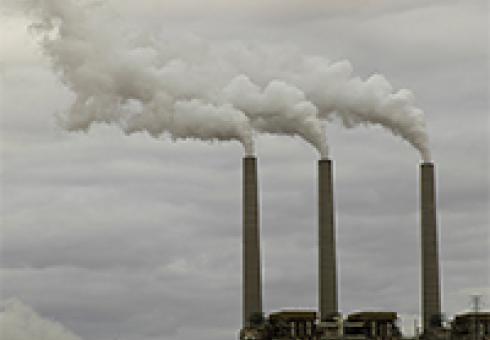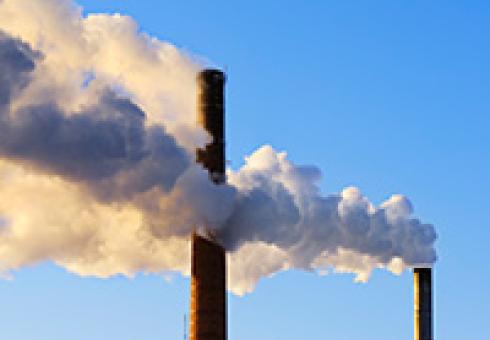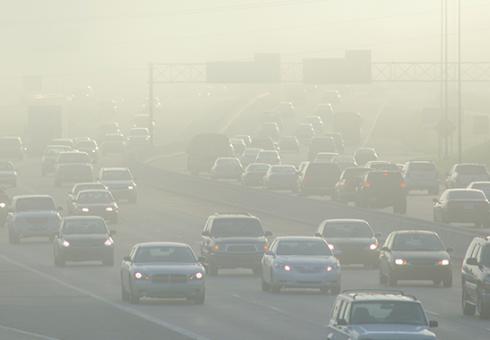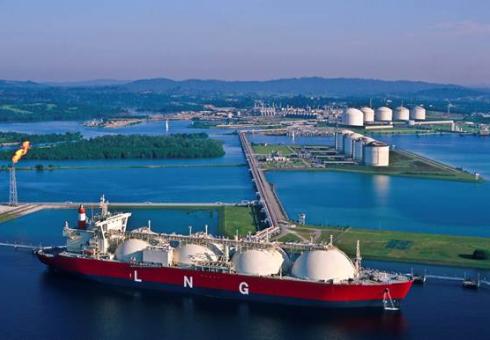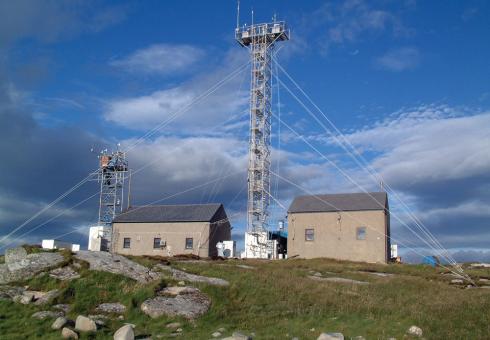News + Media
Julia Pyper, E&E reporter
Published: Monday, November 5, 2013
Targets set in China's latest five-year plan aimed at reducing harmful air pollution from the burning of fossil fuels will result in unintended reductions in carbon dioxide emissions that exceed the country's near-term CO2 reduction goals, according to a new study by the Massachusetts Institute of Technology.
China's rapid economic development has led to a spike in pollution from power plants and the industrial sector. To address pollutants that cause acid rain and smog, the government of China established regulations under the 12th five-year plan to reduce emissions of sulfur dioxide (SO2) by 8 percent and nitrogen oxides (NOx) by 10 percent below 2010 levels by 2015.
The plan also calls for a 17 percent reduction in carbon dioxide intensity from 2010 levels.
In a study published this week in the journal Global Environmental Change, MIT researchers found that China's SO2 and NOx regulations alone could reduce carbon dioxide intensity by 20 percent, surpassing its official near-term target.
"It is clear that the unintended benefits of the regulations are substantial and would allow the government to improve air quality, while also cutting the most potent greenhouse gas. We have also learned that carbon emissions may not rise as high as some forecasts suggest, if concerns about conventional pollutants lead to air-pollution reduction policies," said Kyung-Min Nam, lead author of the study and a postdoctoral associate with the MIT Joint Program on the Science and Policy of Global Change.
Carbon dioxide and conventional air pollutants, like SO2 and NOx, come from the same sources, most often the combustion of fossil fuels. Switching from coal to natural gas or reducing energy use in response to air pollution constraints, therefore, will also reduce carbon dioxide emissions.
It will reduce costs, too. MIT researchers estimate that China's SO2 and NOx regulations will produce $3 billion in reduced compliance costs with carbon dioxide intensity targets.
"Considering that the current CO2 target can be attained by the secondary benefits of the SO2 and NOx regulations, policymakers would do well to coordinate the regulatory efforts," said Valerie Karplus, a co-author of the study and the director of the MIT Joint Program's China Energy and Climate Project, in a statement. "Currently, they have room to adopt more ambitious CO2 reduction policies, but the impact will hinge on effective implementation."
The study finds that China could meet its near-term carbon and pollution goals while still expanding the use of coal. However, this path will have a lock-in effect that makes it more expensive to cut down emissions in future. China can achieve cost savings for industries by requiring earlier action and investment in long-term emissions targets, according to the authors.
"China's local air pollution is extremely serious, and the cost of not acting is too big to ignore," Nam added.
In most of China's major cities, particulate matter concentration levels exceed the World Health Organization's guideline levels by a huge margin, he said. Many studies estimate that health damage from the excess pollution in China is substantial, reaching between 4 and 7 percent of gross domestic product.
"So while reducing pollution in China may require non-trivial compliance costs, it will also increase the welfare of local citizens substantially," Nam said.
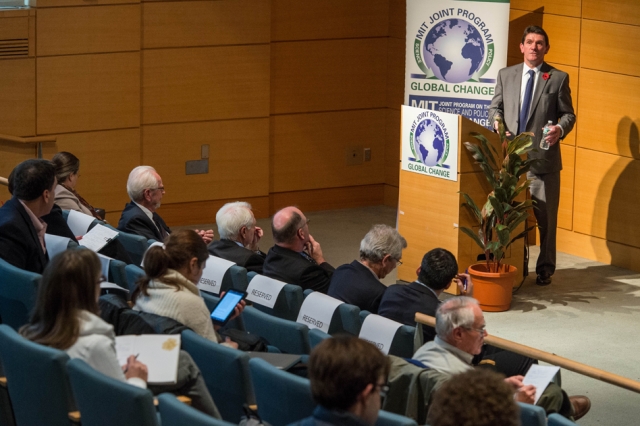
Confronting global environmental change is one of the greatest challenges of our time. Changes to water, land and climate will affect the future of food and agriculture.
China’s unprecedented economic growth has created a more affluent society that demands more energy. The current growth is leading to more emissions from power plants and industries, which threaten human health, the economy and the environment. Government officials recognize the severity of the problem and have taken action through a series of policy initiatives in the 12th Five-Year Plan (2010-2015).
“Power plants, factories and vehicles have all increased sulfur dioxide (SO2) and nitrogen oxide (NOx) pollution, which cause smog and acid rain and lead to health effects such as heart disease, asthma and shortened lifespans,” says Kyung-Min Nam, a researcher in MIT’s Joint Program on the Science and Policy of Global Change. “The increased stringency of new pollution controls reflects a growing recognition of the public health, economic and environmental costs of air pollution in China.”
SO2 and NOx are byproducts of the burning of fossil fuels and other activities that cause CO2 emissions, so limiting these pollutants can also reduce CO2 emissions.
Nam and his colleagues wanted to research effective ways for policymakers to reduce air pollution and mitigate carbon emissions, given the potential interactive effects of these policies.
In a study published this week in Global Environmental Change, they evaluated the unintended CO2 emissions reductions in the new SO2 and NOx regulations in China’s 12th Five-Year Plan. They found that the tighter SO2 and NOx regulations would reduce CO2 enough to allow China to surpass its 2015 goals—by a substantial margin.
“It is clear that the unintended benefits of the regulations are substantial and would allow the government to improve air quality, while also cutting the most potent greenhouse gas. We have also learned that carbon emissions may not rise as high as some forecasts suggest, if concerns about conventional pollutants lead to air pollution reduction policies,” Nam says.
In the 12th Five-Year Plan, the Chinese government committed to reduce SOâ‚‚ emissions by 8 percent and NOâ‚“ emissions by 10 percent from 2010 levels. In addition, the government established a target to reduce CO2 intensity by 17 percent from the 2010 level. The researchers found that by 2015 the SO2 and NOx regulations could reduce CO2 intensity by 20 percent, exceeding China’s official goal.
Valerie Karplus, a co-author of the study and the director of the MIT Joint Program’s China Energy and Climate Project, says, “Considering that the current CO2 target can be attained by the secondary benefits of the SO2 and NOx regulations, policymakers would do well to coordinate the regulatory efforts. Currently, they have room to adopt more ambitious CO2 reduction policies, but the impact will hinge on effective implementation.”
The researchers also estimate that the regulations have the potential to save the Chinese economy $3 billion, the estimated costs of compliance with the CO2 intensity targets.
“We find that China can meet its short-term pollution goals and still expand the use of coal. However, continued use of coal will ultimately make future emissions reductions excessively expensive. The government can achieve greater cost savings for industry by choosing policies that require earlier action and investment in long-term reduction goals,” Nam says. “This emphasizes the need for a forward-looking approach that anticipates more significant reductions in the future and includes cleaner technologies in the near term.”
Nam plans to continue this research by extending the modeling to the U.S. He will compare the unintended benefits of both pollution and climate regulations in China and the U.S. and quantify the interactive effects in both directions.
Editor's note: Climate and energy scientists James Hansen, Ken Caldeira, Kerry Emanuel and Tom Wigley released an open letter Sunday calling on world leaders to support development of safer nuclear power systems.
(CNN) -- To those influencing environmental policy but opposed to nuclear power:
As climate and energy scientists concerned with global climate change, we are writing to urge you to advocate the development and deployment of safer nuclear energy systems. We appreciate your organization's concern about global warming, and your advocacy of renewable energy. But continued opposition to nuclear power threatens humanity's ability to avoid dangerous climate change.
We call on your organization to support the development and deployment of safer nuclear power systems as a practical means of addressing the climate change problem. Global demand for energy is growing rapidly and must continue to grow to provide the needs of developing economies. At the same time, the need to sharply reduce greenhouse gas emissions is becoming ever clearer. We can only increase energy supply while simultaneously reducing greenhouse gas emissions if new power plants turn away from using the atmosphere as a waste dump.
Renewables like wind and solar and biomass will certainly play roles in a future energy economy, but those energy sources cannot scale up fast enough to deliver cheap and reliable power at the scale the global economy requires. While it may be theoretically possible to stabilize the climate without nuclear power, in the real world there is no credible path to climate stabilization that does not include a substantial role for nuclear power.
We understand that today's nuclear plants are far from perfect. Fortunately, passive safety systems and other advances can make new plants much safer. And modern nuclear technology can reduce proliferation risks and solve the waste disposal problem by burning current waste and using fuel more efficiently. Innovation and economies of scale can make new power plants even cheaper than existing plants. Regardless of these advantages, nuclear needs to be encouraged based on its societal benefits.
Quantitative analyses show that the risks associated with the expanded use of nuclear energy are orders of magnitude smaller than the risks associated with fossil fuels. No energy system is without downsides. We ask only that energy system decisions be based on facts, and not on emotions and biases that do not apply to 21st century nuclear technology.
While there will be no single technological silver bullet, the time has come for those who take the threat of global warming seriously to embrace the development and deployment of safer nuclear power systems as one among several technologies that will be essential to any credible effort to develop an energy system that does not rely on using the atmosphere as a waste dump.
With the planet warming and carbon dioxide emissions rising faster than ever, we cannot afford to turn away from any technology that has the potential to displace a large fraction of our carbon emissions. Much has changed since the 1970s. The time has come for a fresh approach to nuclear power in the 21st century.
We ask you and your organization to demonstrate its real concern about risks from climate damage by calling for the development and deployment of advanced nuclear energy.
Sincerely,
Dr. Ken Caldeira, Senior Scientist, Department of Global Ecology, Carnegie Institution
Dr. Kerry Emanuel, Atmospheric Scientist, Massachusetts Institute of Technology
Dr. James Hansen, Climate Scientist, Columbia University Earth Institute
Dr. Tom Wigley, Climate Scientist, University of Adelaide and the National Center for Atmospheric Research
Julia Pyper, E&E reporter
A national emissions trading system in China, placed over the existing patchwork of provincial climate markets, would be the most cost-effective way for the world's top emitter to reduce its carbon footprint, according to a new report by researchers at the Massachusetts Institute of Technology and Tsinghua University in Beijing.
China took a major step forward in combating climate change earlier this year by launching a set of pilot greenhouse gas trading systems within several of its provinces. This is the first in a series of reforms that will help China meet its larger aim to reduce carbon intensity by 17 percent in 2015, relative to 2010 levels.
Ultimately, China's goal is to reduce its carbon dioxide equivalent emissions per unit of gross domestic product by 40 to 45 percent between 2005 and 2020.
But while setting targets at the provincial level is an effective way to cut emissions, a national target would result in a 20 percent lower cost while achieving the same goal, according to the MIT-Tsinghua study published today in the journal Energy Economics.
"If you set targets at the level of individual provinces, there's no opportunity, for example, for one province where the cost of reducing emissions is higher to do less and another province where the cost of reducing emissions is lower to do more," said Valerie Karplus, director of the Tsinghua-MIT China Energy and Climate Project and an author of the study. "A national system achieves the same reduction at lower cost."
Opportunities to reduce emissions in China's eastern provinces are generally more expensive than in western ones, where improving the efficiency of coal-fired power plants, for instance, is relatively cheap, Karplus explained. A national system would improve the distribution of burden among provinces by allowing for exchanges between them.
"To make current approaches increasingly cost-effective, and tailored to meet both ... long-term climate goals as well as near-term air pollution targets, the next step is to move to a national emissions trading system," she said.
Alternative to direct regulation
Harvard University economist Robert Stavins said it's no surprise that aggregating provinces in a single system is more cost-effective than regulating several geographic areas separately. In fact, he would have expected the benefit to be greater than 20 percent.
The Chinese government, eager to reduce its environmental footprint while continuing to grow, has already expressed its intent to move away from siloed provincial policies toward a national system at some point after 2015. The same thing could happen in the U.S., too, said Stavins, who was one designer of the U.S. cap-and-trade system that failed to pass Congress in 2009.
In the absence of a national policy, some parts of the U.S. have established subnational systems, such as California's cap-and-trade program and the Regional Greenhouse Gas Initiative in the Northeast. As in China, the U.S. could eventually move toward a unified pricing policy, Stavins said.
International linkages among early movers are already starting to form, he said. California and Quebec joined forces this year, and Australia is planning to partner with nascent carbon markets in New Zealand and South Korea.
While many countries face political resistance to putting a price on carbon, it remains the single most effective way to address climate change, Stavins said.
"In an economy such as China or the U.S. -- in the industrialized world as well as in the major emerging economies -- the only policy approach that is feasible to achieve truly significant emissions reductions is going to be some kind of carbon pricing regime, whether that is done through a carbon tax or a cap-and-trade system," he said.
"It's inconceivable that direct regulation for these hundreds of millions of different sources of carbon dioxide emissions and, more broadly, greenhouse gas emissions ... could ever be achieved," he added.
Prof Cziczo is interviewed about his research on Contemporary Science Issues & Innovations.
Alli Gold Roberts
MIT Joint Program on the Science and Policy of Global Change
Earlier this year, China took a major step in combating climate change by launching a pilot CO2 emissions trading system within some of its provinces. This is the first step in a series of planned reforms and part of a larger effort to reduce CO2 intensity by 17% in 2015, relative to 2010 levels. 
In a study coming out tomorrow in the November issue of Energy Economics, a group of researchers from MIT and Tsinghua University test the efficiency and equity of the provincial approach by comparing it to a national carbon-trading program. They find that while China can achieve its reduction goal with either a provincial or national level trading system, the national system encourages reductions where they cost the least—resulting in less welfare loss.
“Leaders in China want environmental protection measures to be fair to all regions and households. They also want to choose policies that will be the most cost effective,” says Da Zhang, the lead author of the study and a PhD student with Tsinghua University. “We hope that our research will help policymakers understand the distribution of the burden of alternative policy options, and help them to determine the most cost effective method of reducing CO2.”
Zhang and his coauthors are part of the Tsinghua-MIT China Energy and Climate Project, a collaborative effort between the MIT Joint Program on the Science and Policy of Global Change and the Institute for Energy, Environment and Economy at Tsinghua University in Beijing, China.
The international team finds that imposing CO2 targets at the provincial level results in a consumption loss that is about 20 percent greater than if targets are achieved through a national system. Zhang explains that this is because in a provincial level system, industries may miss out on low-cost opportunities in other provinces and be forced to invest in more expensive abatement measures.
“In contrast, a national target creates incentives to make reductions where they are the cheapest,” says Zhang. “Though we realize there are challenges in implementing a national system, especially when provincial governments are currently accountable for CO2 reductions in their communities.”
To investigate the impacts of this policy, the researchers built a model they call the China Regional Energy Model, or C-REM. The C-REM disaggregates China’s 30 provinces and details the entire energy system. The model also includes global trade data to measure the interactions between China and the global economy.
“This work and the model our team developed are the first steps in our analysis of a broad range of energy and climate policy proposals in China,” says Valerie Karplus, co-author of the study and the director of the Tsinghua-MIT China Energy and Climate Project. “The analysis we produced reflects intensive exchange and learning within our integrated research team.”
She notes future analysis will also include comparing different designs of emissions trading programs and measuring the additional or unintended impacts of air pollution polices.
Anthropogenic emissions that lead to air pollution (particulate matter and ozone) are also large contributors to climate change. Unlike the well-mixed greenhouse gases, the spatial distribution of these emissions affects their climate impact. A better understanding of the role of aerosols and ozone in contributing to historical and projected future climate change provides insight into the relative importance of air pollutants versus well-mixed greenhouse gases, the role of uncertainties in forcing in creating uncertainties in regional climate projections, and the balance between efforts to improve air quality and mitigate climate change.

In his presentation "How Air Pollution Affects Climate and What We Can Do About It", this year's Kendall Lecturer Drew Shindell, a senior scientist at the NASA Goddard Institute for Space Studies in New York City, discussed recent progress in understanding the role of aerosols and ozone and the implications for our understanding of climate sensitivity, of the recent slowdown in global warming, and of the benefits to both climate and human health that can be obtained by taking action to reduce air pollutant emissions.
Dr. Shindell who taught atmospheric chemistry at Columbia University for more than a decade, earned his Bachelor's degree at UC Berkeley and his PhD at Stony Brook University, both in Physics. His research concerns natural and human drivers of climate change, linkages between air quality and climate change, and the interface between climate change science and policy. He has been an author on more than 100 peer-reviewed publications and received awards from Scientific American, NASA, and the NSF. He has testified on climate issues before both houses of the US Congress, the UNFCCC and the World Bank, developed a climate change course with the American Museum of Natural History, and made numerous appearances in newspapers, on radio, and on TV as part of his public outreach efforts. He chaired the 2011 Integrated Assessment of Black Carbon and Tropospheric Ozone produced by the United Nations Environment Programme and World Meteorological Organization. Most recently he was a Coordinating Lead Author on the 2013 Fifth Assessment Report of the Intergovernmental Panel on Climate Change, and chairs the Scientific Advisory Panel to the Climate and Clean Air Coalition of nations.
The Henry W. Kendall Memorial Lecture Series honors the memory of Professor Henry Kendall (1926-1999), a 1990 Nobel Laureate, a longtime member of MIT’s physics faculty, and an ardent environmentalist. A founding member and chair of the Union of Concerned Scientists, he played a leading role in organizing scientific community statements on global problems, including the World Scientists’ Warning to Humanity in 1992 and the Call for Action at the Kyoto Climate Summit in 1997.
Following the lecture there was a reception in the Green Building.
As the U.S. and other large nations experience the benefits of a natural gas boom, smaller countries – from Tanzania to Cyprus – are hoping to reap the rewards too and use the resource to spur their economies. But in a new study, MIT researchers warn them to proceed with caution.

“While natural gas is often cheaper than oil and gives off fewer emissions, developing the resource comes with risks, especially for smaller nations,” says Sergey Paltsev, an author of the study and a principal research scientist at the MIT Energy Initiative. “The cost for these smaller nations makes up a larger portion of their economies, so before spending the money, they need to have the proper expectations.”
In collaboration with the Cyprus Institute, the MIT researchers take an independent look at the economics around developing the resource using Cyprus as an example. They find that it will take the country about five years to put their natural gas resource to use, and the required investments will make up to a quarter of the country’s Gross Domestic Product (GDP).
“That’s a substantial amount of a country’s economy dependent on a resource that has proven to be unpredictable in the past,” says Paltsev, who is also the assistant director for economic research at the MIT Joint Program on the Science and Policy of Global Change. “Natural gas development is so new to such regions, and the global gas market is changing so rapidly, that there’s a large amount of uncertainty.”
This is the message the researchers will bring to a November meeting with Cyprus decision-makers, meant to help the leaders plan a path forward with realistic expectations in mind.
The Case of Cyprus
What’s happening in Cyprus is a good model for other countries like it that are exploring natural gas, according to Paltsev.
The small nation has been teetering back from a near collapse of its banking industry and searching for revenue. When a major natural gas reserve was discovered off its coast two years ago, Cyprus leaders saw it as a golden opportunity.
The latest estimate of the resource at that site, given earlier this month, shows about 5 trillion cubic feet of gas. To put that into context, the researchers cite a 2013 BP report showing the global supply of natural gas to be about 6,600 trillion cubic feet, with Russia’s reserves alone being 1,160 trillion cubic feet.
“These numbers tell us that, while this is a significant find for a country the size of Cyprus, it’s only a small fraction of the global resources,” says Francis O’Sullivan, the director of research for the MIT Energy Initiative. “Most likely, Cyprus will never be a major player in the global gas markets, but that doesn’t mean natural gas can’t benefit the country’s economy if developed properly.”
One trillion cubic feet of natural gas is enough to meet the needs of 5 million households for 15 years, according to the American Gas Association. With the population of Cyprus being just around a million, the study shows that Cyprus has enough natural gas to power the country for nearly a century – while significantly reducing its use of foreign oil.
LNG versus a Pipeline
An ample resource for domestic use, the Cyprus government has made plans to build a Liquefied Natural Gas (LNG) plant and export the resource to such place as Europe and Israel.
LNG has been the preferred option over building a pipeline because of political tensions in the area. The island has been divided since the mid-1970s, with Turkey occupying the northern half.
While a clear political maneuver, building an LNG terminal would also create jobs and raise revenue. Depending on the tax scheme, it may raise $1.5 billion in taxes. Still, it would cost about $6 billion to build, for a country that has a GDP of about $25 billion. The cost of building an LNG terminal is far more than the cost of building a pipeline, though LNG offers greater flexibility to adjust production to changing natural gas prices and market supplies – perhaps outweighing the upfront costs.
“The discovery of natural gas has created exciting opportunities for Cyprus and could transform the country’s energy system and position in the region,” O’Sullivan says. “But the cost of developing the resource makes up about a quarter of the country’s economy. That’s not insignificant, and it’s a major risk if it fails.”
O’Sullivan and Paltsev warn that even projects that start out having clear economic gains can become less profitable because of poor technical planning and execution or bureaucratic and regulatory delays.
“Prices change, projects get delayed, overrun costs pile up. These are all unforeseen risks that can come up and must be properly mitigated,” Paltsev says.
The study, funded entirely by the Cyprus Research Promotion Foundation, is part of a larger report that will further take into account the changing dynamics of the regional and global gas markets – giving a comprehensive view of the implications for the long-term development of natural gas in Cyprus and other like nations. The researchers expect to finish that larger report in August 2014.
Photo Credit: ©iStock.com/MsLightBox
The Advanced Global Atmospheric Gases Experiment (AGAGE), meets this week in Boston for their biannual meeting and to celebrate their 35th anniversary.

